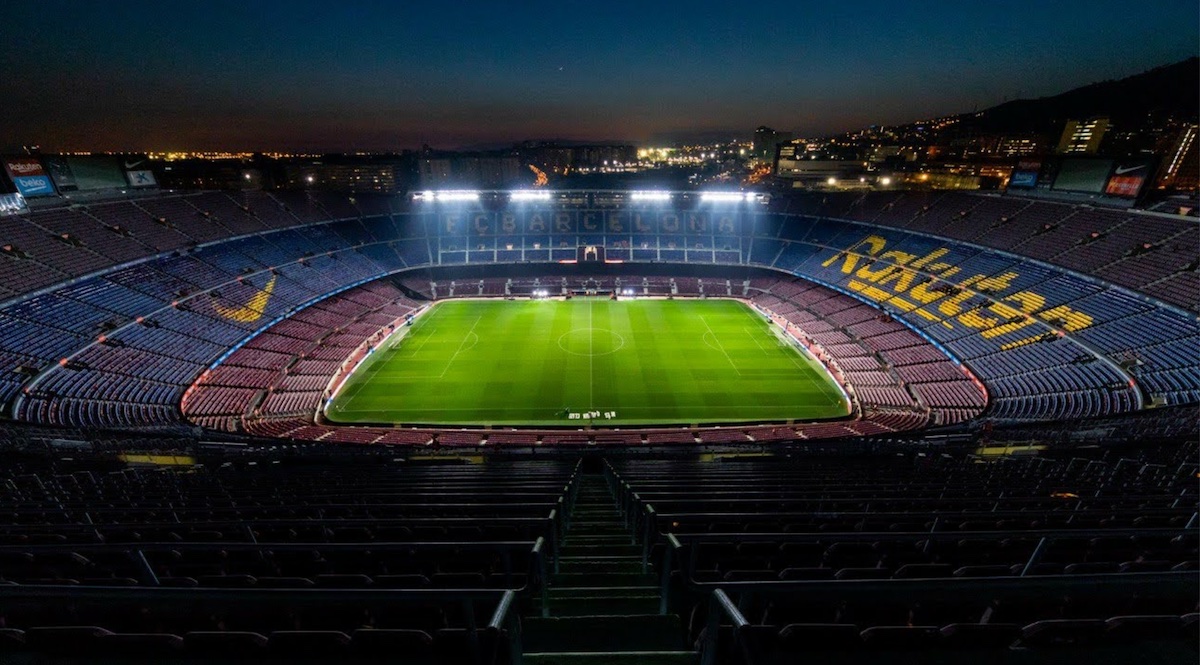Largest Soccer Stadiums in the World – Top 10 for 2023
Known as ‘Soccer’ in North America and ‘Football’ in most other parts of the world, few sports can draw attendances to the same awesome capacity and atmosphere as some of the largest soccer stadiums in the world. Soccer or ‘the beautiful game’ as it is known, is the most popular sport on the planet with at least 3.5 billion fans worldwide. With Soccer ‘leagues’ in virtually every country in the world as well as country specific tournaments and International tournaments such as the World Cup (the largest sporting event in the world), large crowds are normal and big stadiums are needed!
Crowd sizes throughout Soccer’s history have always been huge. Indeed even back in 1950, Brazil’s famed ‘Maracana’ stadium saw nearly 200,000 fans packed into its famous stands to witness the World Cup Final between Brazil and Uruguay. An event which set a world record for the largest attendance at a Soccer stadium ever! A record which remains to this day.
Times have changed however and as the game grew safety came to the fore and modern stadiums were changed to ‘all seater’ as opposed to the stadiums of old which had ‘terraces’ where people could stand and thereby allowed for a greater number of fans. Whilst this initially lowered crowd capacities in stadiums, the growth of the game has meant stadiums have improved and the new all seater stadiums can and do now hold huge amounts of people. Let’s take a look at the top 10, largest Soccer stadiums in the world.
Top 10 Largest Soccer Stadiums In The World
10. The Borg El Arab Stadium – Egypt
Capacity 86,000
Completed in 2007 and located in Egypt, the Borg El Arab Stadium is the second largest soccer stadium in Africa and can hold up to 86,000 fans. Built as part of Egypt’s unsuccessful bid to host the 2010 FIFA World Cup Finals, the Borg El Arab Stadium was notably filled to capacity in the 2018 World Cup qualifying match between Egypt and Congo
9. Bukit Jalil National Stadium – Malaysia
Capacity 87,411
Located in Malaysia’s Capital, Kuala Lumpur, the Bukit Jalil National Stadium is currently the largest soccer stadium in South East Asia. The stadium was built to completion in 1998 in order to host the Commonwealth Games of the same year. As its name suggest, the stadium is home to the Malaysian national soccer side and has also played host to several international soccer tournament and events.
8. The ‘Estadio Azteca’ – Mexico
Capacity 87,523
The Azteca stadium as it is known in English was built in 1966 and is located in Mexico City. ‘The Azteca’ is famous for a number of reasons. Firstly, for playing host to two World Cup Finals. The 1970 World Cup Final won by ‘Pele’s’ Brazil and the 1986 World Cup Final won by Diego Maradona’s Argentina.
In both instances the venue was filled to capacity. Secondly, ‘The Azteca’ is notable for the number of private boxes it has for corporate clients – 856 in total. An amount of premium seating largely unsurpassed in soccer stadiums around the world.
7. Wembley Stadium – England
Capacity 90,000
Quite simply, ‘Wembley’ in London, England is universally recognised as ‘the home of football’ or soccer as it’s known in the US. The current stadium is actually a new version of the original which was built in 1923 and famed for its ‘Twin Towers’. Sadly, these towers were lost in a total rebuild of the same site which was completed in 2007. The new Wembley, however, it’s one of the most famous soccer stadiums in the world for its own reasons; a giant 133 meter tall arch that serves as the main support structure for the sliding roof that sits 52 meters above the pitch.
Although the roof does not close completely, it does cover every seat in the stadium which makes Wembley the largest fully covered stadium in the world. Wembley amongst other is home to the English national soccer side and the FA Cup and League Cup Finals which are played there. The most famous moment in its history occurred in 1966 when it played host to the World Cup Final and England defeated West Germany 4-2 to loft the ‘Jules Rimet’ trophy.
6. The Rose Bowl – USA
Capacity 92,542
Built in 1922 and located in Pasadena, California, the Rose Bowl is probably more well-known for hosting Rock Concerts and Super Bowls than it is for Soccer. Nevertheless, the Rose Bowl is a noted Soccer venue having hosted the 1984 Olympic Soccer Gold Medal Match, the 1994 FIFA World Cup Final and the 1999 Women’s FIFA World Cup Final. Ensuring it is the only stadium in the world to have held these three prestigious tournaments.
5. FNB Stadium – Africa
Capacity 94,736
Located in the South African city of Johannesburg, the FNB Stadium is the largest soccer stadium in Africa. Known as ‘Soccer City’, the stadium was completed in 2009 so it could host games in the 2010 World Cup Finals which were held in South Africa. Symbolic in stature, the new stadium was reconstructed from the original ‘Apartheid’ era stadium which was built in 1989.
4. Camp Nou – Spain
Capacity 99, 354
‘Camp Nou’ or the ‘Nou Camp’ as is it often referred to in English is the home stadium of one of the giants of European soccer – FC Barcelona. Based in Catalonia, Spain, Camp Nou is the largest football stadium in Europe. Originally built in 1957, Camp Nou is undergoing a major reconstruction which will see its capacity rise to 105,000 and an almost space age structure emerge.
An iconic stadium which has hosted the following; two European Cup/Champions League finals in 1989 and 1999; two European Cup Winners Cup finals; four Inter-Cities Fairs Cup finals; five UEFA Super Cup games; four Copa del Rey finals; two Copa de la Liga finals; and twenty-one Supercopa de España finals. It also hosted five matches in the 1982 FIFA World Cup including the opening games well as two out of four matches at the 1964 European Nations’ Cup and the soccer tournament’s final at the 1992 Summer Olympics. Camp Nou is simply European royalty as a stadium.
3. Melbourne Cricket Ground – Australia
Capacity 100,024
As its name implies, Melbourne Cricket Ground was designed primarily to host cricket matches way back in 1853. Nevertheless, the stadium has also hosted other events including soccer matches. Arguably its most famous match was the Olympic Soccer final between USSR and Yugoslavia held on the 8th of December, 1956. In 1997, the venue also hosted its first FIFA-recognized international soccer match. A World Cup qualifying game between Australia and Iran that saw 98,000 fans in attendance. Known locally as the ‘G’ stadium, it is the largest in the Southern hemisphere.
2. The AT&T Stadium – USA
Capacity 105,000
Best known as the home of American football’s Dallas Cowboys, this magnificent arena has also hosted soccer matches. Notably hosting the following matches recently:
- The CONCACAF Gold Cup semi-final on July 22, 2017. The United States defeated Costa Rica, 2–0.
- The 2018 International Champions Cup on July 31, 2018. AS Roma defeated FC Barcelona, 4–2.
Located in Arlington, Texas this extremely modern arena is the largest ‘domed’ stadium in the world and has a retractable roof. Moreover, in the middle of the stadium hangs a giant high definition television screen which is the largest in the world.
1. Rungrado First of May Stadium – North Korea!
Capacity 125,000 -150,000
It seems somewhat ironic that the largest Soccer stadium in the world is located in what many consider the world’s most isolated country. Located in Pyongyang, the North Korean capital, the Rungrado First of May Stadium allegedly has a capacity of up to an enormous 150,000 people. At least, this is what the North Koreans claim! The actual capacity is thought to be nearer to 114,000 which would still make it the largest Soccer stadium in the world. Albeit that limited Soccer taken place there;
- The Rungrado Stadium playing host in July 2017 to six group stage matches as part of 2018 AFC U-23 Championship qualification.
The only soccer event of note seemingly to have taken place there. Inaugurated in 1989, the stadium is recognized as the largest Soccer stadium in the world.
*Note ‘The Rungrado’ is also regarded as the second largest non-Soccer stadium in the world behind ‘The Narendra Modi Stadium’ in India which is cited as the largest stadium in the world (for Cricket) with a seating capacity of 132,000 spectators.
What is the largest soccer stadium in the world?
Located in Pyongyang, the North Korean capital, the Rungrado First of May Stadium allegedly has a capacity of up to an enormous 150,000 people. At least, this is what the North Koreans claim!
A fan and participator of more or less all sports up to University level from Burnley, England. I am now writing as a freelance sports journalist. My speciality in particular lies in global Football (soccer) – which I played to a semi-professional level.







